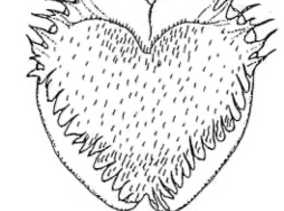You are here
Acianthinae_species
Corybas hispidus D.L. Jones
Nomenclature
-
Subgenus: CorysanthesSection: Corysanthes
-
Synonyms: 1
SUMMARY
Leaves: 15-35 mm. in diameter, cordate to orbicular, green on both sides
Bract: small, narrow.
Ovary: about 6 mm. long, narrow
Flower: 18-25 mm. long, reddish-purple, dominated by the lamina of the labellum, sessile or almost so.
Dorsal sepal: 20-25 x 10-12 mm. when flattened out, greenish-grey spotted with dark purple, cucullate, concave, broadly spathulate, obtuse, much contracted in the proximal one third.
Lateral sepals: about 6 x 0.8 mm., deflexed tapered from base to extremity; apex ± bifid.
Lateral petals: about 6 x 0.5 mm. slightly falcate, forming broad wings at the base where they join the column, torn tapering to filiform points.
Labellum: longer than the dorsal sepal; labellum-tube 5-7 mm long much shorter than the lamina, erect for about 5 mm. then abruptly decurved through about 180° and greatly expanded into a broadly oval or deltoid lamina; lamina 16-22 mm long reddish-purple with a conspicuous white central boss, its margins deeply fringed with purple fimbriae up to 5 mm long
Boss: dome-like, conspicuously hispid, notched in the upper 1/3, the minute teeth especially obvious on the margins of the notch.
Auricles: small, directed obliquely upward, the opening 1.2-1.4 mm. in diameter.
Column: about 3 mm. long, dilated anteriorly in the proximal half, prominently winged. Stigma ± 2 mm. in diameter, ± reniform, concave. Anther ± 9 mm. long, entire. Pollinarium 1.4 x 1.0 mm. long, consisting of 4 pollinia in two pairs attached directly to a reniform viscidium 0.7 mm. long.
Type: Mt. Hamilton, N.E. Victoria, ± 51- miles north-north-east from Wulgulmerang Post Office— D. L. Jones & K. C. Rogers, 20 March 1972 (Mel). Isotypes at Mel, NSW, K.
Distribution: At present known from north-eastern Victoria in highland areas and south-western and central-western N.S.W., extending as far north as Botobolar near Mudgee. An extension of range is to be anticipated due to previous confusion with C. fimbriatus (R.Br.) Reichenb. f.






